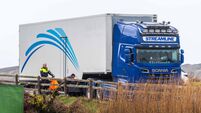Field of Dreams not immune to threats
Since Ireland West Airport (as Knock is now formally known) began commercial flights in 1985, it has successfully adopted the movie’s own “build it and they will come” philosophy.
The former parish priest of Knock, Monsignor James Horan lived to see his dream become a reality, happily declaring its official opening in 1986 to be “the greatest day in the history of Connacht for a hundred years”.
Although the airport was often used by TV crews to depict the heartbreak of emigration in its early years, it has since come to typify a new entrepreneurial spirit that has sprung up in the west on the back of the Celtic Tiger economy.
Today Knock is our fourth busiest airport and largest of the country’s six commercial regional airports, having grown tenfold from 55,000 passengers in its first full year of operation to about 556,000 in 2007. The importance of the airport to the local economy also cannot be overstated as it provides 1,000 jobs in the region and 900,000 bed nights (accommodation) for tourists each year, worth an annual €62m.
However, a mixture of good and bad news in recent months means Knock, like most other Irish airports, is facing an uncertain future.
The Government has announced that it will cut spending on the capital funding of regional airports by €13m in a move that could threaten some of Knock’s €46m investment programme, including an extension to the terminal building, a new perimeter fence and improved landing system.
In addition, Ryanair’s Michael O’Leary declared last month that the airport’s commercial viability was “flaky”, a comment humorously met with a neat marketing ploy as Knock airport staff gave out free bars of Cadbury’s Flake to departing passengers.
Knock has previously proven resilient to various setbacks and it hopes that it can meet future challenges as easily as it does O’Leary’s barbs. It also enjoys a huge advantage over the competing airports at Galway and Sligo, with which it shares part of a catchment area of 900,000, as its 2,300-metre runway is capable of handling most large passenger aircraft.
It allowed Flyglobespan to operate transatlantic flights to New York and Boston in 2007, although these services have been discontinued and are unlikely to return in the short term. Nevertheless, Knock has set itself ambitious targets of delivering 700,000 passengers this year and one million by 2010, especially as passenger traffic in 2007 actually fell by more than 12%.
So far this year, results are good with Knock announcing last week that passenger numbers in the first seven months of 2008 are up 20% over the corresponding period last year. The number of customers using the airport has risen by 63,000 to almost 372,500 passengers with the increase attributed to new services to Bristol and London and increased seat capacity on London routes.
However, Knock’s chief executive, Robert Grealis, admits that the entire aviation sector is facing a difficult trading environment in the upcoming winter season.
While Ryanair will begin a new daily service to Liverpool from October 27, Grealis does not anticipate any significant growth in new destinations in the short term. Indeed, Knock was dealt a fresh blow at the start of the month when XL Airways confirmed that it was stopping its London Gatwick service from September 2.
It came just a short time after Cityjet announced that it would not be in a position to take up the franchise to operate the state-subsidised PSO (public service obligation) route to Dublin, which it won just a few months ago from the existing holder, Aer Arann.
As a result, there has been no Dublin-Knock service since July 21. Ryanair has offered to step into the breach and operate one daily service in each direction but stipulated that it would be mid-day flights — a schedule not so attractive for business passengers.
Grealis believes Knock’s real competition lies not so much in its neighbouring rivals but other regional airports across the EU.
“Essentially we are competing for the use of the aircraft of Ryanair and other airlines that can be deployed at any airport around Europe,” reasons Grealis.
Regardless of subsidies, Grealis accepts that the airport’s future is the maintenance and growth of direct access services to key destinations in Britain and continental Europe, whether provided by Michael O’Leary or not.












